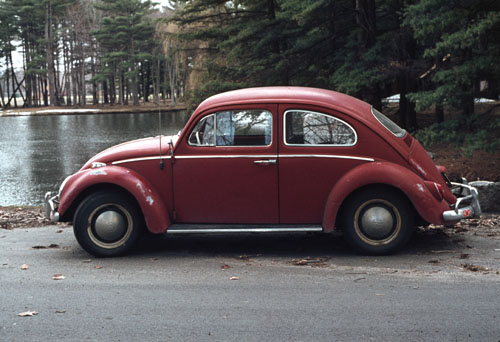The Volkswagen Beetle, along with its stable mate, the VW Bus, was a radically different type of car. During the times of political upheaval, the Beetle stood out as a symbol of individuality and nonconformity.
The VW Bug, affectionately called the VW Bug, was first imported to the US in the 50s. Soon, it took off in popularity and became one of the best-selling cars of the 60s. It was cheap, the ’61 Beetle sold for only $1565. That’s the equivalent of about $15,000 in 2023. Of course, it was cheap because it was so simple, but it was still very much below its nearest rival, the AMC Rambler at $1998. Which one of these do you still see on the road today?
Along with affordability, the car’s unique rounded shape added to its non-conformist reputation. And the fact that the engine was in the back and trunk was in the front added to its uniqueness. Of course, having a whopping 40 hp during the time that V8s ruled the road was a bit different too.
The Counterculture Car
After all, the late 50s and early 60s were still the time of longer and wider gas guzzling American cars, many with fins to boot. So, the Bug, with its unusual styling and minimal features became the darling of the counterculture. Driving one was a badge of rejection of traditional values and an embrace of change.
The funny thing is, I don’t recall seeing very many new VW bugs on the road. Most were older and a bit beat up. Or maybe it just seemed that way. They were often customized with bright colored paint jobs, peace symbols, flowers, or multiple bumper stickers. They were rolling protest signs.

Unique Mechanical Features
The VW Bug was designed differently than most other cars on the road.
Aside from its small size, which was unusual in itself, it had an engine in the rear. The only other common rear-engine car was the Corvair and it was a lot more expensive. The trunk in the front was pretty skimpy because it held the gas tank. And drivers often got funny looks at the gas pump when they put the nozzle in the “wrong” end.
The rear engine was a unique design too. It was a flat four whereas most other cars of the time used a V or L shape design. It was compact and sat low in the car for improved handling. There was no radiator. The engine was air-cooled which was partially responsible for the Beetle’s unique sound. Of course, no radiator meant that the heat was lousy.
Having the engine in the back allowed more space and a flat floor in the cabin. It all but eliminated the long hood of most American cars. And made for great traction in the snow!
Everything on the Beetle was simple. There was almost no chrome aside from the bumpers. Windows had hand cranks and rubber gaskets. The windshield, rather than being swept back, was near-vertical, small, and in your face.
The suspension was beam axle and torsion bars, which gave a smooth ride for a small car and good handling. This design was both rugged and reliable, and it helped to keep the car’s cost low.
All in all, the Beetle was a great basic transportation car but didn’t have the bells and whistles that fit in with the mainstream. And that’s why it became a hippie mobile.